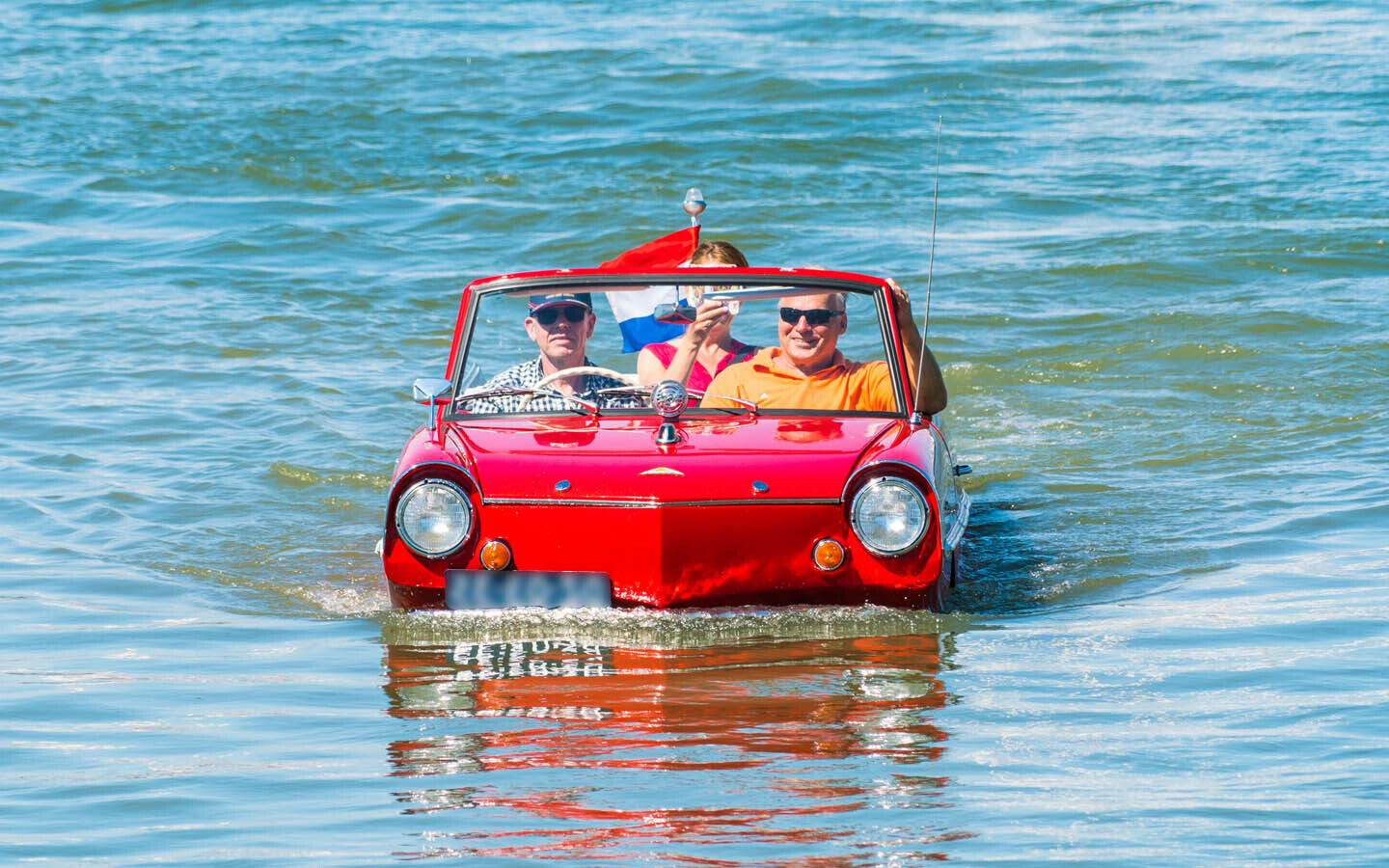
Amphibious cars are vehicles that can travel on both land and water. These unique machines combine the best of both worlds, offering the convenience of a car with the versatility of a boat. But what makes them so special? Amphibious cars have a fascinating history, from their military origins to their modern recreational uses. They come in various designs and models, each with its own set of features and capabilities. Whether you're a car enthusiast or just curious about these incredible vehicles, you'll find plenty of interesting facts to fuel your curiosity. Buckle up and get ready to dive into the world of amphibious cars!
Key Takeaways:
- Amphibious cars are versatile vehicles that can travel on both land and water, combining the functions of a car and a boat. They have retractable wheels and water propulsion systems for seamless transitions.
- Modern amphibious cars feature advanced technologies such as GPS navigation systems, hydrofoils, and safety equipment. They have also made appearances in popular culture, including movies, video games, and car shows.
Amphibious Cars: A Blend of Land and Water
Amphibious cars are fascinating vehicles capable of traveling on both land and water. These unique machines combine the functionality of a car with the capabilities of a boat. Let's dive into some intriguing facts about amphibious cars.
-
Amphibious cars can transition seamlessly between land and water. They are designed with special mechanisms that allow them to switch modes quickly, making them versatile for various terrains.
-
The first amphibious car was invented in 1905. Known as the "Gibbs Aquada," this early model paved the way for future innovations in amphibious vehicle technology.
-
Amphibious cars often have retractable wheels. These wheels can be pulled up when the vehicle enters the water, reducing drag and allowing for smoother navigation.
-
They are equipped with water propulsion systems. These systems, such as jet drives or propellers, enable the car to move efficiently through water.
-
Amphibious cars are used by military forces. Their ability to traverse both land and water makes them valuable for military operations, especially in regions with diverse terrains.
Historical Milestones in Amphibious Car Development
The journey of amphibious cars is marked by several key milestones. These developments have shaped the evolution of these unique vehicles.
-
The "Schwimmwagen" was used during World War II. This German military vehicle could navigate rivers and lakes, providing a strategic advantage.
-
The "Amphicar" was the first commercially available amphibious car. Released in the 1960s, it could reach speeds of up to 7 knots on water and 70 mph on land.
-
The "Gibbs Aquada" set a world record in 2004. It crossed the English Channel in just over an hour, showcasing the potential of modern amphibious cars.
-
The "WaterCar Panther" is one of the fastest amphibious cars. It can reach speeds of 45 mph on water and 80 mph on land, making it a high-performance vehicle.
-
Amphibious cars have been featured in movies and TV shows. They often appear in action scenes, highlighting their versatility and unique capabilities.
Engineering Marvels of Amphibious Cars
The engineering behind amphibious cars is nothing short of remarkable. These vehicles incorporate advanced technologies to ensure smooth transitions and efficient performance.
-
Amphibious cars have watertight seals. These seals prevent water from entering the vehicle, ensuring safety and buoyancy.
-
They use lightweight materials. Materials like aluminum and fiberglass reduce weight, enhancing both land and water performance.
-
Advanced suspension systems are crucial. These systems allow the vehicle to handle rough terrains on land and provide stability in water.
-
Some models feature automatic mode switching. This technology enables the car to switch between land and water modes without manual intervention.
-
Amphibious cars often have dual steering systems. One system controls the vehicle on land, while the other manages navigation in water.
Modern Innovations in Amphibious Car Design
Recent advancements have pushed the boundaries of what amphibious cars can achieve. Modern designs focus on improving efficiency, safety, and user experience.
-
Electric amphibious cars are emerging. These eco-friendly models reduce emissions and offer quieter operation.
-
Hydrofoils are being integrated into some designs. Hydrofoils lift the vehicle above the water, reducing drag and increasing speed.
-
Amphibious cars now feature GPS navigation systems. These systems help drivers navigate both land and water routes more effectively.
-
Safety features have been enhanced. Modern amphibious cars come with life jackets, emergency flares, and other safety equipment.
-
Luxury models are available. High-end amphibious cars offer premium interiors, advanced entertainment systems, and other luxury features.
Amphibious Cars in Popular Culture
Amphibious cars have captured the imagination of many, appearing in various forms of media and pop culture.
-
James Bond drove an amphibious car. In "The Spy Who Loved Me," Bond's Lotus Esprit transformed into a submarine, thrilling audiences worldwide.
-
Amphibious cars are popular in video games. Games like "Grand Theft Auto" feature these vehicles, allowing players to experience their unique capabilities.
-
They are a hit at car shows. Amphibious cars often steal the spotlight at automotive exhibitions, drawing crowds with their dual functionality.
-
Some amphibious cars are used in tourism. Tour operators use them for unique sightseeing experiences, offering tours that cover both land and water.
-
Amphibious cars have inspired toy models. Many toy manufacturers produce miniature versions, sparking interest in young enthusiasts.
Challenges and Future Prospects
Despite their many advantages, amphibious cars face certain challenges. However, ongoing research and development promise exciting future prospects.
-
High production costs are a barrier. The complex engineering and materials required make these vehicles expensive to produce.
-
Regulatory hurdles exist. Amphibious cars must meet both automotive and maritime regulations, complicating their approval process.
-
Maintenance can be challenging. The dual nature of these vehicles requires specialized knowledge for repairs and upkeep.
-
Fuel efficiency is a concern. Balancing performance on land and water often leads to higher fuel consumption.
-
Future models may use alternative fuels. Research into hydrogen and solar-powered amphibious cars aims to address environmental concerns.
Fun Facts About Amphibious Cars
Amphibious cars are not just engineering marvels; they also come with some fun and quirky facts.
-
Some amphibious cars can float indefinitely. Their buoyant design allows them to stay afloat even when stationary.
-
They can be used for fishing. Enthusiasts often use them to access remote fishing spots, combining travel and leisure.
-
Amphibious car races exist. Events like the "Amphibious Car Challenge" test the speed and agility of these vehicles on both land and water.
-
They have been used in rescue missions. Their ability to navigate flooded areas makes them valuable in emergency situations.
-
Amphibious cars can be customized. Owners often personalize their vehicles with unique paint jobs, accessories, and modifications.
The Final Splash
Amphibious cars are fascinating machines blending land and water travel. These vehicles, from the 1960s Amphicar to modern innovations, showcase human ingenuity. They offer unique experiences, letting drivers switch from roads to rivers seamlessly. While not mainstream, their appeal lies in versatility and adventure.
Understanding amphibious cars means appreciating their history, technology, and potential. They remind us of the endless possibilities in automotive design. Whether for military use, rescue missions, or pure fun, these cars have carved a niche in transportation history.
So next time you see one, remember the blend of engineering and creativity that makes it possible. Amphibious cars are more than just vehicles; they're a testament to human innovation and the desire to explore new frontiers. Dive into the world of amphibious cars and discover a unique blend of land and water travel.
Frequently Asked Questions
Was this page helpful?
Our commitment to delivering trustworthy and engaging content is at the heart of what we do. Each fact on our site is contributed by real users like you, bringing a wealth of diverse insights and information. To ensure the highest standards of accuracy and reliability, our dedicated editors meticulously review each submission. This process guarantees that the facts we share are not only fascinating but also credible. Trust in our commitment to quality and authenticity as you explore and learn with us.


